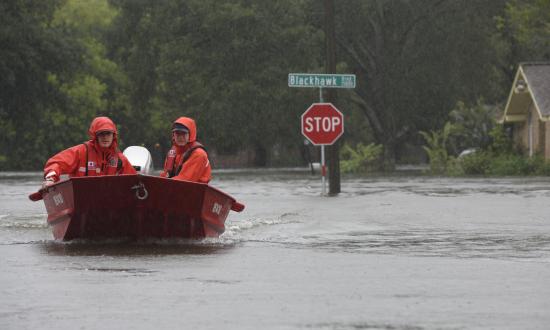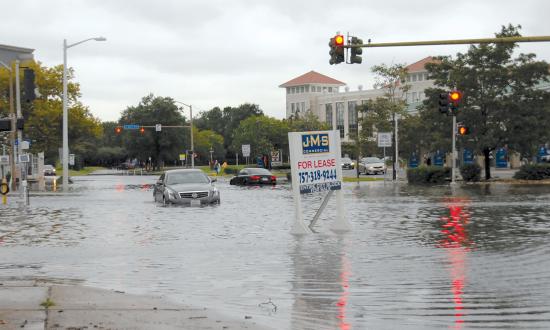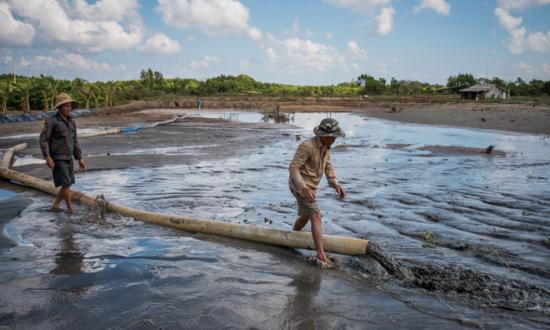In his November 2011 speech to the Australian Parliament in Canberra, President Barack Obama articulated his stance on the U.S. foreign policy future in the Pacific, stating, “Our enduring interests in the region demand our enduring presence in the region. The United States is a Pacific power, and we are here to stay,” and continued, “So let there be no doubt: In the Asia-Pacific in the 21st century, the United States of America is all in.”
This speech framed the intent to pivot U.S. diplomatic and military efforts to the Pacific. A decade has passed since the Canberra speech, yet the challenges of the physical, political, and cultural geographies of the Indo-Pacific region have persisted and continue to evolve. They do so amidst China’s expanding influence and the impacts of climate change.
The changing nature of the Earth’s physical geography creates both security challenges and collaborative opportunities for American diplomatic and military leadership. The physical sciences community overwhelmingly accepts the consensus that changing climate patterns result from a net warming of the Earth’s surface, air, and oceans, and are driven principally by human activity. The likely effects of climate change have caught the consistent attention and concern of the most recent Commanders of the U.S. Indo-Pacific Command (INDOPACOM—Admirals Locklear, Harris, Davidson, and Aquilino). Climate change is also expected to increase the scale, frequency, and complexity of future missions. Due to severe weather events, sea level rise, coastal populations, and vulnerable infrastructure, the many impacts of climate change are increasingly likely to affect the member states of the Association of Southeast Asian Nations (ASEAN) and other countries in INDOPACOM’s Area of Responsibility (AOR). Three foreseeable challenges of food security, human physical security, and Chinese hegemony create opportunities for U.S. leadership involving multiple instruments of national power.
Historical and Scientific Backdrops
As Assistant Secretary of the Navy, Theodore Roosevelt was greatly influenced by Captain Alfred Thayer Mahan’s 1890 book, “The Influence of Sea Power Upon History 1660-1783.” Of the six general conditions which this book identified that affected a nation’s sea power, three of them involve physical geography.1 In the ensuing decades, U.S. presidential administrations took advantage of these conditions to transform the U.S. into a global maritime power. Today, the combined effects of changing geographic realities increase the U.S. economic, territorial, and security challenges, particularly in the Indo-Pacific region. A lack of strategic focus and political backing are likely to result in inadequate responses to these challenges. China’s continued emergence as the regional hegemon also coincides with the observable effects of accelerating climate change.
Climate change involves a complex interplay of interrelated physical systems. Naturally, human social and economic systems are affected by extreme, fluctuating, or unforeseen changes in their natural environment. This illustrates the connection between climate change (changing physical geography) and human challenges (political and economic geography). This now frames the next portion of the predicament, which involves how changing physical geographies will influence sea power in the 21st century.
A Wicked Problem Set
The effects of climate change have been of great concern to U.S. military commanders and planners for some time. Benchmarking to 2011, the year of President Obama’s Canberra speech, economic losses from climate change were estimated to eventually reach up to 20 percent of global GDP, with the World Bank estimating global adaption costs of $75 to $100 billion per year between 2010 and 2050.2 Around the start of the “Pacific Pivot,” 40 percent of global economic growth was attributed to the Indo-Pacific region, which also encompasses some of the most devastating poverty on Earth. Growing gaps between the “haves” and “have-nots” lead to disenfranchisement and cross-border population shifts. The INDOPACOM AOR is also the world’s most disaster-prone, containing 80 percent of all natural disaster occurrences. As articulated in a 2021 National Intelligence Estimate, the risks to U.S. national security interests will be increased by climate change.
The pan-Asian economy showed resilience through the first year of the coronavirus pandemic. This economy shrank by only 1.5 percent in 2020, compared with 3.2 percent shrinkage for the world economy at large. The pan-Asian economy is also expected to rebound faster in the near future. A significant fraction of world economic growth is concentrated in nations residing in the Indo-Pacific region. Yet, they can be particularly impacted by climate change and associated severe weather shocks. Additionally, U.S. military, economic, and political interests are located within the AOR, as well as infrastructure upon which global trade depends. Clearly, the challenges facing the region persist. With the settings and problems articulated and framed, several challenge-opportunity pairings become apparent.
Challenge and Opportunity I—(Population Support)
Challenge
Population support in the form of food security is a huge concern for ASEAN nations and coastal portions of mainland Asia. These populations reside largely in coastal cities and are supported by low-lying agricultural areas, both of which are particularly vulnerable to climate effects. Recent work at the intersection of the physical and political sciences have investigated these interrelationships. For instance, as temperatures deviated from an agricultural optimum of around 20C, asylum applications in nearby countries increased in a nonlinear fashion. This implies that increased migrations will accompany future temperature fluctuations.
Changing rain patterns can result in inundation of flood-sensitive areas, while laying previously fertile agricultural regions fallow.3 Melting polar ice caps alter the seawater salinity of the uppermost ocean layers. Production of localized “dead zones,” devoid of economically meaningful sea life, are predicted to result from oxygen depletion in particular parts of the ocean. These effects could drive regional seafood stocks farther offshore to deeper waters, or even contribute to ecosystem collapse if critical portions of ocean food webs are disrupted. Rising populations and unstable food stocks are not a stable duo.4
Opportunity
Coordination between governmental aid agencies and nongovernmental organizations (NGOs) presents an opportunity for the geographic military chief to serve as a principal humanitarian coordinator. While acting as a military diplomat, the INDOPACOM commander can exercise soft power to demonstrate resolve to potential adversaries, reassure traditionally skeptical nations, and reinforce ties with solid regional partners. This soft power could also generate diplomatic benefits by cementing and enhancing relationships with regional nations.
This need not be viewed as mission creep for a military organization, but as an exercise of instruments of national power. As an example, U.S. aid to the Philippine typhoon response (2013) with subsequent bi-national training exercises, and assistance for Indonesians affected by an earthquake and tsunami (2018) produced benefits to these international relationships. Future exercises could leverage the cooperative security paradigm embraced by the ASEAN nations, building trust and influence throughout the region.
Challenge and Opportunity II—(Human Physical Security)
Challenge
The concern of human physical security closely flows from Challenge I. If the local landscape becomes uninhabitable or unable to support the population, that population will certainly move. Suppose a series of environmental shocks pressure the coastal populations of the ASEAN nations. The natural consequences include internally displaced persons and cross-border refugees, which put pressure on socio-political institutions and upon the state relations with adjacent nations. Such will have the clear potential to destabilize the societies and governments of various countries, especially where insufficient or ill-coordinated responses fail to allay the human pain. Food security and population displacement have contributed to protests and riots throughout history, resulting in social and political change.5
With populations moving between sovereign nations and landmasses, acrimonious relationships among governments often arise. If a nation’s governance and institutions are ill-suited to respond, masses of climate refugees will likely place pressure upon adjacent nations. For example, imagine large waves of climate refugees from the Indonesian and adjacent islands arriving on the northern shores of Australia, to Mainland Southeast Asia, or to China. Each of these nations and regions are culturally dissimilar to Indonesia, with existing social and economic challenges of their own. Crime, civil unrest, and nationalistic protectionism against refugee waves are natural consequences of forced migrations and general insecurity. Destabilization and openings for conflict are natural consequences of such scenarios.
Opportunity
The coordinated execution of humanitarian operations can prevent or lessen such destabilizing effects, reducing the likelihood of such crises expanding into armed conflicts. This is an opportunity for U.S. leadership as a regional coordinator in preemptive humanitarian assistance and disaster preparedness. The focus would be to enhance the working relationships with historically U.S.-aligned nations and those nations whose affinities are in transition or open to influence. Combined military exercises could benefit the working relationships between militaries and diplomatic services through non-combat operations. Such humanitarian and civil affairs cooperation will also build the working relationships, after-action reports, case studies, and experiences which the participating nations can leverage when responding to a variety of actual disasters across the world. Such multilateral exercises prepare all participants to be comfortable with uncertainty. This can also convey resolve to protect U.S. interests, and to ensure stability and security in the region.
Challenge and Opportunity III—(Collaborative Infrastructure Improvements)
Challenge
China’s Belt and Road initiative, exploitation of international agreements such as UNCLOS, and exploitive economic practices cause concern and distress throughout much of the Indo-Pacific.6 China’s single-party political structure and heavy administrative culture provide a variety of advantages in long-term strategic planning and execution. Unlike Western liberal democracies, China is not subject to the opinion swings of a voting public. The challenge then involves identifying and building the means through which capitalist democracies can counter an emerging regional hegemon and do so through democratic capitalist institutions.
Opportunity
An opportunity exists in encouraging more visible and tangible U.S. commitments in ASEAN and the surrounding nations through cooperative infrastructure developments. This has benefits for many stakeholders. Facilities such as airports, shore facilities, aids to navigation, sustainable power production, and waterways promote global trade. Modernized infrastructures, designed for extreme weather resilience, can continue their intended functions under increased stressors. U.S. cooperation and leadership has great potential to bring the hosting nations more into our sphere of influence, which is a potential antidote to the one-by-one cleave-off of nations into the servitude of an emerging power. This situation plays to the collaborative strengths of consensual capitalist partners and can be done through a variety of means. Public-private partnerships, direct foreign aid, NGOs and facilitated private financing involving U.S. Government organizations provide a variety of means of acting on this opportunity.7 This can encourage development and investment in resilient infrastructure in ASEAN and regional nations, while doing so in a free, collaborative, democratic, and capitalist fashion.
Commitments which combine the convening power of government with the flexibility of U.S. private capital, the willing cooperation of Indo-Pacific host nations, and unique capabilities of diverse and consenting organizations can produce visible and lasting contributions to resilient infrastructure in the region. This approach combines many elements of national power, spanning the “DIME” aspects of diplomatic, informational, military, and economic powers. This would be beating China at its own game, but through mutually beneficial collaboration instead of exploitive takeovers.
Looking Forward
The Indo-Pacific region will be particularly affected by climate change. The physical geographies of the region are very susceptible to extreme weather shocks exacerbated by climate change. Cascading political and economic effects will reach across the world. The U.S. vision for the Indo-Pacific includes the exercise of sovereignty free from coercion, where growth and connectivity are promoted in sustainable ways. Opportunities I through III are well-aligned with that vision. A decade after the Canberra speech, American political will is sufficient to drive requests for serious Asia-focused military funding.
Alfred Thayer Mahan has proven prophetic, as sea power depends greatly upon the physical geography of the sea. More than a century of study, observation, and experience since Mahan have shown how interconnected global systems truly are, as physical, political, and economic geographies increasingly convolve with each other. Challenges abound in the Indo-Pacific, and the U.S. must choose if, whether, and how to consummate the opportunities. Yet, like a potentially strong hand of poker or a chess gambit, other actors get a vote as well. Our choices will affect how this turns out.
1. Thayer Mahan, The Influence of Sea Power Upon History 1660–1783, 12th editionof 1918, (Boston, Little Brown and Company: 1890), 28–29.
2. Scott Victor Valentine, “Towards the Sino-American Trade Organization for the Prevention of Climate Change (STOP-CC),” The Chinese Journal of International Politics, vol. 4, 2011. Figures quoted were presumably in circa 2010 dollars, just before the publication date of the cited article.
3. Troy Sternberg, “Chinese Drought, Wheat, and the Egyptian Uprising: How a Localized Hazard Became Globalized,” in Werrell Caitlin E. and Francesco Femia, eds. The Arab Spring and Climate Change: A Climate and Security Correlations Series, Washington, D.C.: Center for American Progress, February 2013, 7–14.
4. For context, consider the situation as reported around the time of Obama’s Australia speech. The South China Sea accounted for approximately 10 percent of the annual global fisheries catch. Also, the South China Sea is of paramount importance to the fishing industries of the nearby countries with the National Intelligence Council predicting in 2012 that world demand for food will rise by at least 35 percent by 2030.
5. Office of the Under Secretary of Defense for Acquisition, Technology, and Logistics, Trends and Implications of Climate Change for National and International Security, October 2011.
6. The United Nations Convention on the Law of the Sea of 10 December 1982. This convention has been ratified by nearly all of the Earth’s nations, including China (ratified 7 June 1986). The United States has not yet ratified the convention but has for a related agreement on conservation and management of fish stocks. A long running controversy involves the U.S. expectation that nations observe “norms” of UNCLOS, while the United States has not itself ratified the said treaty.
7. Such as the US International Development Finance Corporation, formerly knowns as the Overseas Private Investment Corporation (OPIC).






